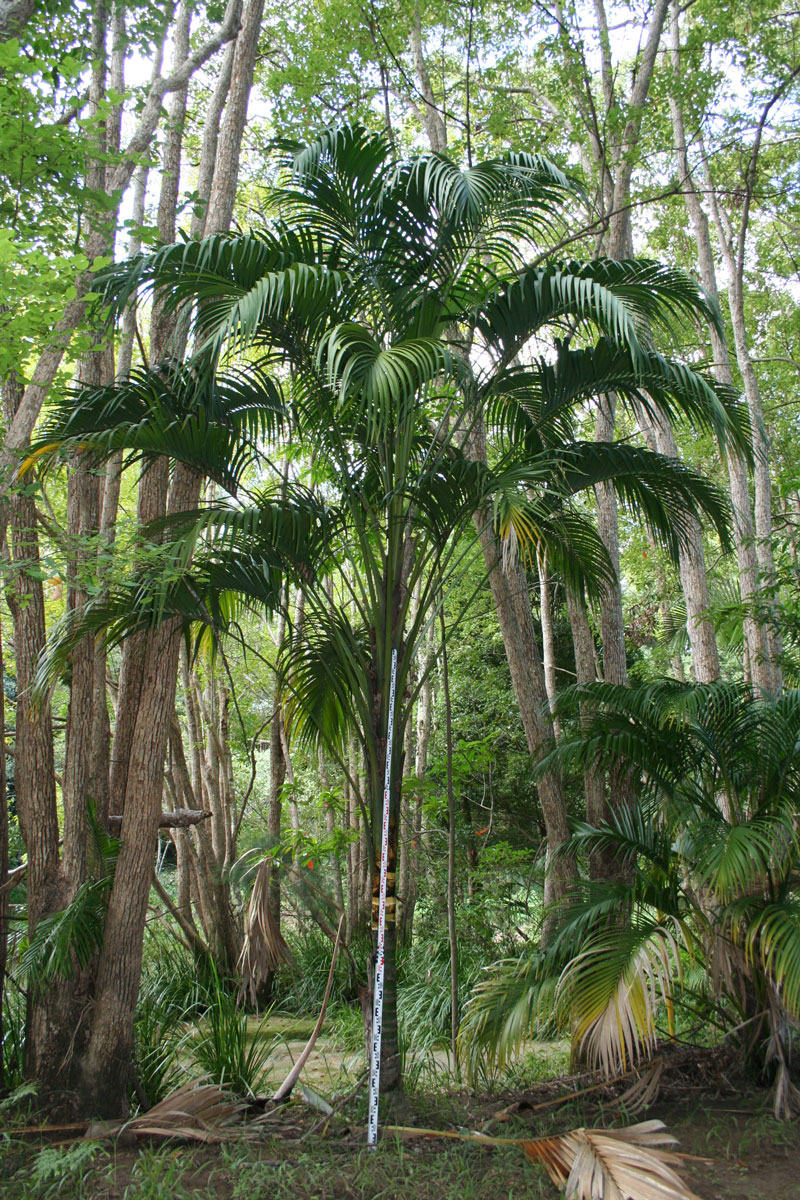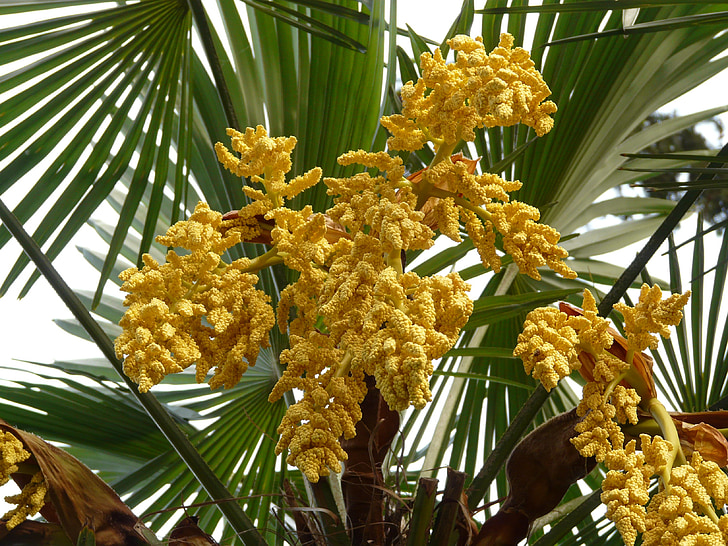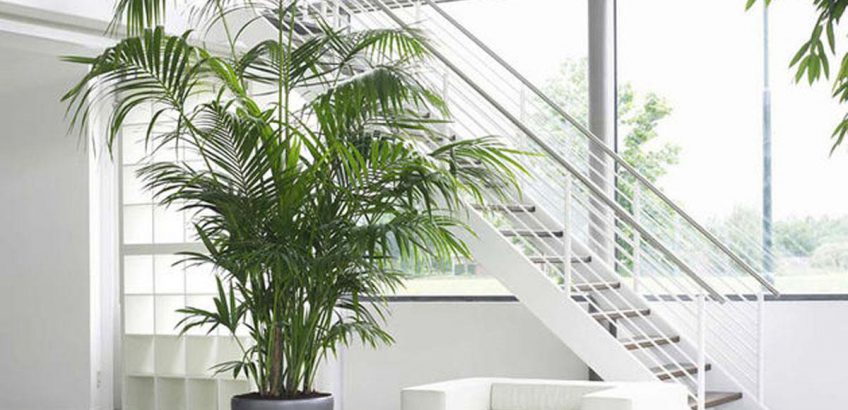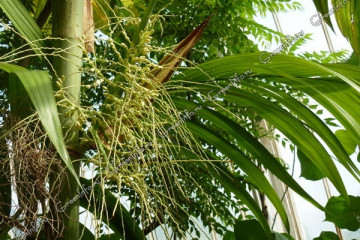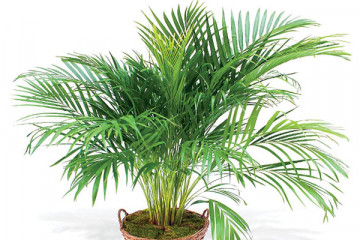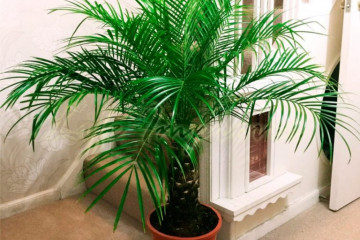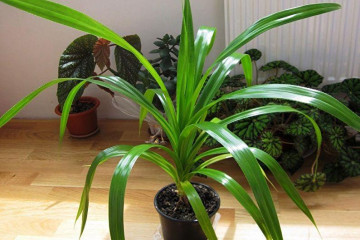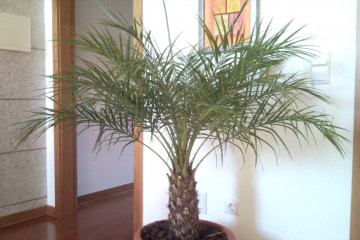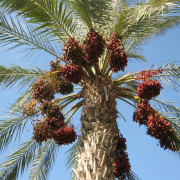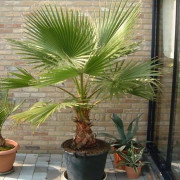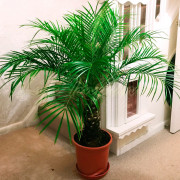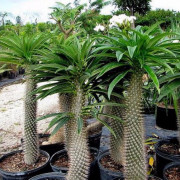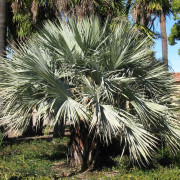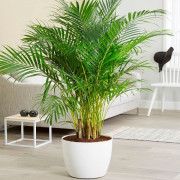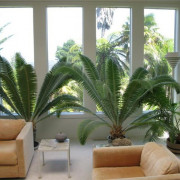Hovea palm - home care
Content:
The hovea palm tree in the wild lives only on the coastal sands and volcanic rocks of the very small island of Lord Howe, located in the Tasman Sea between Australia and the island of New Caledonia, which made it possible to attribute it to endemic plants, that is, to those that are found on very limited area. The capital of the island - Kentia gave the second name to the palm tree - Kentia.
Home-grown hovei species
The hovea flower belongs to the genus of palms, the Arecaceae family. It is one of the largest families of flowering plants; it grows up to 15 meters high in its homeland.
The trunk has cicatricial framing rings, from which large feathery leaves up to 4.5 m long grow.
Hanging inflorescences appear in the axils of the leaves, and fruits are formed. The sight of luxurious palm trees attracted the attention of the colonists of Western Europe, so the beauty found herself far from home and gained popularity in the Old World.
The house palm tree hovea in growth (up to 3 m) is significantly inferior to the plant that grew on the island, without losing its southern flavor and charm.
There are 2 types of home grown:
- hoveya Forster;
- hovei Belmore.
Hoveya Forster
Another name is Forsteriana, in nature it grows up to 15 m. The trunk is straight, with the same diameter along the entire height. A wide leaf plate of a rich dark green color, feathery, slightly curved, its length reaches 2.5 m, is attached to petioles up to 1.5 m long.
This species is more resistant to cold, without consequences it tolerates a decrease in temperature to 10 ° C.
Hovea Belmora
This palm is not high, in nature it reaches 10 m. The trunk is wider at the base.
A leaf up to 4.5 m long consists of several narrow leaves, forming a leaf plate curved downwards, which is located on a short petiole no more than 40 cm.
The growth rate in rooms is slow; in a favorable room climate, it can reach 3 m.
Reproduction of hovea
Reproduction of hovea can be implemented:
- Sowing seeds;
- Seating or dividing the bush.
By dividing the bush
A mixture is preliminarily prepared, consisting of:
- Leaf humus - 2 parts.
- Sod land - 1 part.
- Perlite - 2 parts.
A container with a volume corresponding to the size of the palm root system is selected.
The following operations must be performed sequentially:
- Gently remove the plant from the pot.
- Shake the root ball lightly to scatter the soil.
- You must continue to remove soil from the roots manually so as not to damage the roots.
- Carefully cut the plant apart, avoiding damage to the roots and making sure they do not dry out.
- Plant the delenki in a prepared dish with a potting soil mixture.
- Drizzle.
Rooting occurs when:
- Bright but diffused light.
- Temperature 20-25 ° C.
- Air humidity at 50%.
Water the plantings when the mixture dries to a depth of 2 cm. Protect from drafts. Rooting will take place in 1-2 weeks. Rooted seedlings are fed by preparing a solution with the addition of half the dose of fertilizer required for an adult plant.
Sowing seeds
This method is not always successful and time-consuming. Seeds remain viable for six months. They are soaked in water for 5 days. Choose pots with a capacity of no more than 200 ml. Prepare a soil consisting of sheet earth, perlite and vermiculite in a 1: 1: 1 ratio. Fill containers, not reaching the top of 1.5 cm, moisten. To better sprout, slightly damage the hard shell of the seed with a file. Sow one at a time, bury it and sprinkle it a little with earth. Cover with foil or glass on top, creating humidity up to 100% inside.
For successful germination it is necessary:
- Maintain air and ground temperature at least 27 ° С.
- Provide partial shade.
- Ventilate daily.
- Make sure that the soil does not dry out.
The probability of emergence of seedlings within 6 months. When the seedlings grow up to 2-4 cm, they are transplanted into containers designed for an adult specimen.
During the spring and summer of the first year, seedlings are placed in partial shade.
Hovea transplant at home
Young specimens are transplanted every year, preferably in spring, transferring to a larger pot with an earthen clod.
For two, - and three-year ones, once every two years is enough, for adults - once every 5 years. A mixture of sod land, sand and peat is used for this. When replanting a plant, do not forget about drainage. To renew the substrate, the top layer is changed annually.
Care Tips
Unpretentious javea flower easily adapts in bad conditions, it is easy to care for it.
To grow an attractive flower, certain rules must be followed:
- Maintain temperatures up to 24 ° C in summer and 16-18 ° C in winter.
- Water with lukewarm water only.
- Spray when the air is dry.
Over time, hovea leaves begin to dry out and die off, which is considered natural. In this case, the number of dried and newly regrown leaves should be the same.
At low humidity, the tips of the leaf dry out, they are carefully trimmed. Regularly, you need to wipe the leaves with a damp sponge, sometimes use a shower.
The plant is sensitive to tobacco smoke and musty odors and requires constant ventilation, but drafts should be eliminated.
Watering
The best water for irrigating hovea is rainwater. It is allowed to use boiled strained water.
In the warm season, with active vegetation, abundant watering is needed. Watering twice a week will be sufficient. In the fall and winter, they water it as the soil dries out, but it is impossible to bring the earthen coma to dryness. It is also necessary to take into account the temperature: when it decreases, watering is reduced.
Air humidity for hovei
In spring and summer, the plant, in addition to watering, requires increased humidity, it is created by spraying.
Seat selection
Placing a palm tree anywhere in the home is good for its habitat. On the south side, in the heat, you need to create a shadow. In winter, additional lighting is used, including a fluorescent lamp.
Correct lighting
The palm tree is shade-tolerant, any room is suitable for growing it, but growth will slow down in a shaded place. A place with intense diffused light will be suitable for placing a flower.
In winter, hovei needs little care and lighting. In order for the palm tree to evenly grow its leaves, it is periodically turned in different directions to the light.
Fertilization
During the growing season, young plants need feeding with special mineral fertilizers for palms once every two weeks.You can use fertilizers for ornamental foliage plants containing potassium, magnesium and phosphorus. They are used in liquid form. For adult specimens, 1 time per month is enough. In winter, they refuse to feed.
Sanitary pruning
Formative pruning is not needed, you should only remove broken and obsolete leaves at the very base in time, using sharp tools: a knife, pruning shears.
Diseases of Hovea
The appearance of brown spots on the entire surface of the leaf indicates a disease - leaf spot (pink rot). The diseased plant is treated with fungicides several times until it recovers.
Young leaves suffer from chlorosis; the introduction of trace elements will help to cope with the disease. Weak specimens are exposed to diseases. The reason is more often violations in the care of the palm tree.
Pests
The appearance of pests cannot be ruled out:
- Spider mites, scale insects and mealybugs, which are destroyed with insecticides.
- Thrips, they will be defeated by Aktara.
- The aphids will remove the laundry soap.
When growing, the following problems arise:
- A young plant takes a lot of time - frequent transplants, adherence to temperature and watering, maintaining humidity.
- The size of the palm tree exceeds the size of the room.
- Delayed measures taken to combat diseases and pests that led to the death of the pet.
Drying leaves
Noticing that the leaves are drying, you must immediately take measures to avoid losing your pet.
The reason may be:
- Lowering the temperature below 18 ° C.
- The presence of tobacco smoke and other harmful substances in the air.
- Dry topsoil.
Eliminating these factors will return the hovei to its normal appearance.
Popular hoveya home care for which is not too difficult. All expenditures of time and effort are compensated by a living green miracle that has settled in the house and reminds of the warm summer and the sea.
